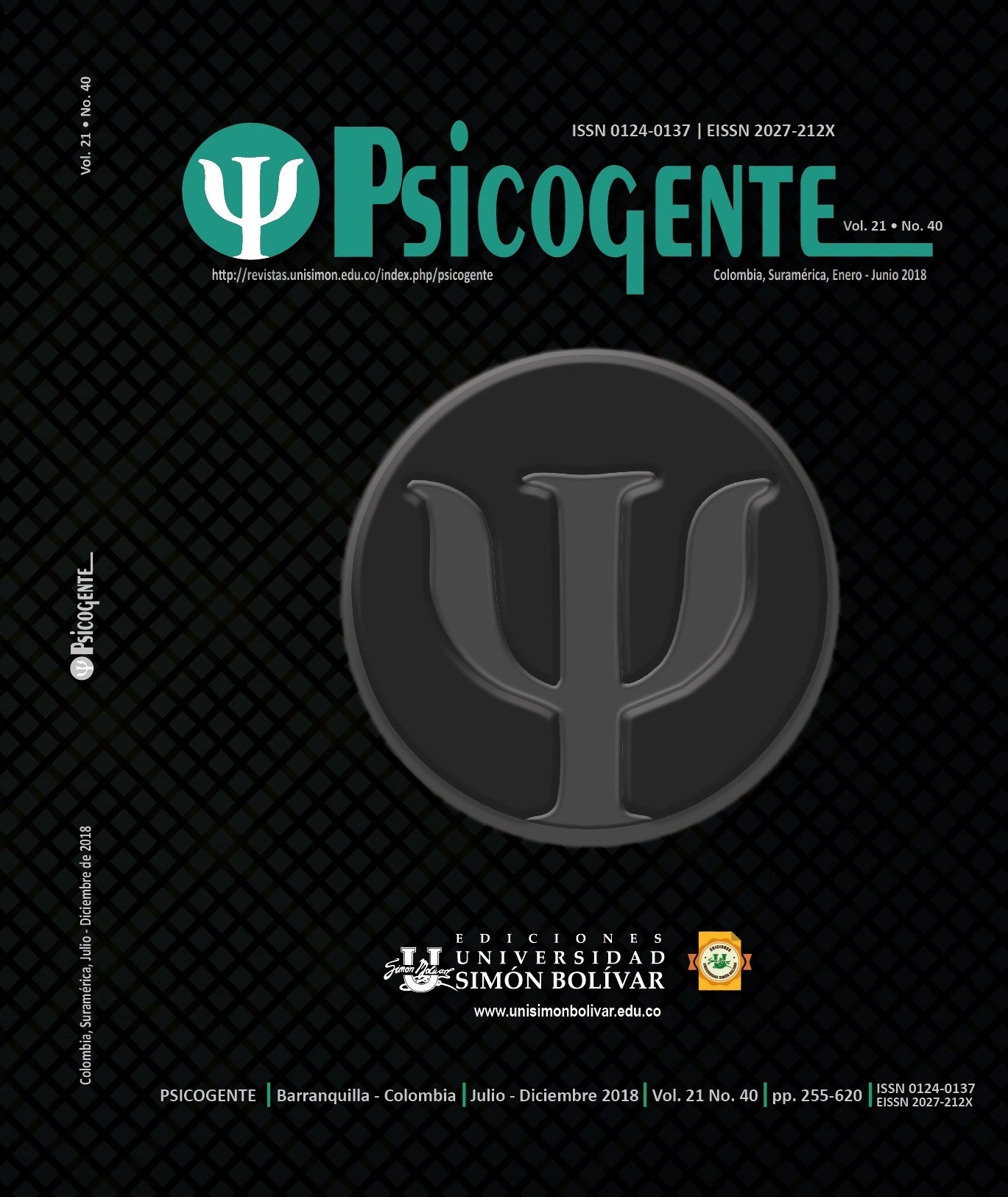Validación de una prueba para medir eventos vitales estresantes en adultos gay, lesbianas y bisexuales colombianos
Validation test in order to measure stressful life events in Colombian gays, lesbians and bisexual adults
DOI:
https://doi.org/10.17081/psico.22.41.3305Palabras clave:
eventos vitales estresantes, orientación sexual, estudios de validación, adultos colombianosResumen
Objetivo: Evaluar las características psicométricas de una prueba para valorar eventos vitales estresantes PEVE, así como comparar el constructo según sexo, edad y orientaciones sexuales no heterosexuales residentes en tres ciudades de Colombia, Barranquilla, Bogotá y Tunja.
Método: Se implementó un muestreo no probabilístico tipo Bola de Nieve mediante el cual, 208 participantes con edades entre 18 y 67 años (ME= 26.16, DE=8.56) diligenciaron la PEVE, que medía diversos eventos estresantes (EE).
Resultados: La consistencia interna obtenida a través de alfa de Cronbach fue 0,79 y el Omega de McDonald fue de 0,89. El 34,62% no experimentó EE durante el pasado año, el 56,25% experimentó bajos niveles y sólo un 9,13% experimentó EE en alto grado. Análisis Paralelo y Test MAP sugieren un único factor que explicó el 54% de la varianza. Los EE en mujeres se asocia con mayor proporción de discusiones con la familia debido a su homosexualidad (p<.05), mientras que EE en hombres se asocia con problemas con la policía y ser agredido físicamente (p<.05). Con relación a orientación sexual, EE se asocian con mayor proporción de homosexuales que reportan problemas con familiares en comparación de la proporción de bisexuales (p<.05). Con respecto a la edad, adultos jóvenes tienden a experimentar mayores niveles promedio de EE que adultos (p<.05).
Conclusión: En población LGB colombiana, PEVE muestra adecuada validez de constructo y consistencia interna. La mayoría de participantes perciben un nivel bajo de EE y éstos niveles varían teniendo en cuenta variables como el sexo, orientación sexual y edad. Se requieren más investigaciones en contextos latinoamericanos.
Descargas
Citas
Allport, G. W. (1954). The nature of prejudice. Reading, MA: Addison-Wesley.
Ardila, R. (2008). Homosexualidad y Psicología. (2 ed.). Bogotá: El Manual Moderno.
Baams, L., Grossman, & A., Russell, S. (2015). Minority stress and mechanisms of risk for depression and suicidal ideation among lesbian, gay, and bisexual youth. Developmental Psychology, 51, (5), 688-696. http://dx.doi.org/10.1037/a0038994
Barrantes, R., Eaton, A., Veldhuis, C., & Hughes, T. (2017). The Role of Minority Stressors in Lesbian Relationship Commitment and Persistence Psychology of Sexual Orientation and Gender Diversity The Role of Minority Stressors in Lesbian Relationship. Psychology of Sexual Orientation and Gender Diversity, 4 (2), 1–13. http://doi.org/10.1037/sgd0000221
Brewster, M. E., Moradi, B., DeBlaere, C., & Velez, B. L. (2013). Navigating the Borderlands: The Roles of Minority Stressors, Bicultural Self-Efficacy, and Cognitive Flexibility in the Mental Health of Bisexual Individuals. Journal of Counseling Psychology, 60(4), 543–556. Doi: http://doi.org/10.1037/a0033224
Brooks, V. R. (1981). Minority stress and lesbian women. Lexington, MA: Lexington Books
Bybee, J. A., Sullivan, Æ. E. L., & Zielonka, Æ. E. (2009). Are Gay Men in Worse Mental Health than Heterosexual Men ? The Role of Age, Shame and Guilt, and Coming-Out. Journal Adult Development, 16, 144–154. http://doi.org/10.1007/s10804-009-9059-x
Calvo, Y. (2013). Homoparentalidad: explorando el reconocimiento social y los derechos de los homosexuales en la ciudad de San Luis, Argentina. Psicogente, 16(29), 118-131. http://revistas.unisimon.edu.co/index.php/psicogente/article/view/1945
Campo-Arias, A., Herazo, E. & Oviedo, H. (2017). Correlación entre actitud hacia homosexualidad femenina y masculina en estudiantes de Medicina. Psicogente, 20(37), 172-180. http://doi.org/10.17081/psico.20.37.2426
Charyton, C. (2007). What Is the Relationship Between Sexual Orientation, Bisexuality and Creativity?. Journal of Bisexuality, 6(4), 49-69. http://doi.org/10.1300/J159v06n04_05
Durkheim, E. (1951). Suicide: A Study in Sociology. New York: Che Free Press. Ehlers, V. J., Zuyderduin, A., & Oosthuizen, M. J. (2001). The well-being of gays, lesbians and bisexuals in Botswana. Issues and Innovations in Nursing Practice, 35, (6), 848–856. https://doi.org/10.1046/j.1365-2648.2001.01922.x
Goffman, E. (1963). Stigma: Notes on the management of spoiled identity. New York: Touchstone.
Hequembourg, A. L., & Brallier, S. A. (2009). An exploration of sexual minority stress across the lines of gender and sexual identity. Journal of homosexuality, 56(3), 273-298. https://doi.org/10.1080/00918360902728517
Huebner, D. M., & Davis, M. C. (2007). Perceived Antigay Discrimination and Physical Health Outcomes. Health Psychology, 26(5), 627–634. http://doi.org/10.1037/0278-6133.26.5.627
Konik, J., & Crawford, M. (2004). Exploring normative creativity: Testing the relationship between cognitive flexibility and sexual identity. Sex Roles, 51(3), 249-253. https://doi.org/10.1023/B:SERS.0000037885.22789.83
Kinsey, A., Pomeroy, W., Martin, C. (1948). Sexual behavior in the human male. Philadelphia, Pa: WB Saunders Co
Kuyper, L., & Fokkema, T. (2011). Minority stress and mental health among dutch LGBs: Examination of differences between sex and sexual orientation. Journal of Counseling Psychology, 58 (2), 222-233. https://doi.org/10.1037/a()022688
Link, B. G., & Phelan, J. C. (2001). Conceptualizing stigma. Annual Review of Psychology. 27, 363–85. https://doi.org/0360-0572/01/0811-0363
Lock, J., Ph, D., & Steiner, H. (1999). Relationships between Sexual Orientation and Coping Styles of Gay, Lesbian, and Bisexual Adolescents from a Community High School. Journal of the Gay and Lesbian Medical Association, 3 (3), 77-82. https://doi.org/10.1023/A:10222359107493.
Lorenzo-Seva, U., & Ferrando, P. J. (2006). FACTOR: A computer program to fit the exploratory factor analysis model. Behavior research methods, 38(1), 88-91. https://doi.org/10.3758/BF03192753
McDaniel, J., Purcell, D., & D´Augelli, A. (2001). The relationship between sexual orientation and risk for suicide: Research findings and future directions for research and prevention. Suicide and Life-Threatening Behavior, 31, 84-105. https://doi.org/10.1521/suli.31.1.5.84.24224
Mcdermott, E., Roen, K., & Scourfield, J. (2008). Avoiding shame : young LGBT people, homophobia and self-destructive Avoiding shame : young LGBT people, homophobia and self-destructive behaviours. Culture, Health & Sexuality, 10(8), 851–829. https://doi.org/10.1080/13691050802380974
Meyer, I.H. (1995). Minority stress and mental health in gay men. Journal of Health and Social Behavior, 36 (1), 38-56. https://doi.org/10.2307/2137286
Meyer, I. H. (2003). Prejudice, social stress, and mental health in lesbian, gay, and bisexual populations: Conceptual issues and research evidence. Psychological Bulletin, 129, 674-697. http://doi.org/10.1037/00332909.129.5.674
Meyer, I.H., & Frost, D. (2013). Minority Stress and the Health of Sexual Minorities. In C. J. P. and A. R. D’Augelli (Ed.), Handbook of Psychology and Sexual Orientation (Firs Editi, Vol. 6, pp. 252–266). Oxford University: Oxford University. https://doi.org/10.1093/acprof
Meyer, I.H., Frost, D.M., & Nezhad, S. (2015). Minority Stress and Suicide in Lesbians, Gay Men, and Bisexuals. In: Peter Goldblum, Dorothy L. Espelage, Joyce Chu, and Bruce Bongar (Eds.). Youth Suicide and Bullying: Challenges and Strategies for Prevention and Intervention (pp. 177-187). New York: Oxford University Press.
Mirowsky, J., & Ross, C. E. (1989). Social causes of psychological distress. New York: Aldine de Gruyter.
Montero, I., & León, O. G. (2007). Sistema de clasificación del método en los informes de investigación en Psicología. International Journal of clinical and health psychology, 5(1). Health and Social Behavior, 36, 38-56. https://doi.org/10.2307/2137286556
Ortiz-Hernández, L. (2005). Influencia de la opresión internalizada sobre la salud mental de bisexuales, lesbianas y homosexuales de la Ciudad de México. Salud Mental, 28(4), 49–65. http://www.scielo.org.mx/scielo.php?script=sci_arttext&pid=S0185-33252005000400049
Pineda Roa, C. A. (2016). Propiedades psicométricas de una prueba de homonegatividad internalizada en varones homosexuales y bisexuales colombianos. Psicología desde el Caribe, 33(1), 47-65. https://dx.doi.org/10.14482/psdc.33.1.8074
Rosario, M., Hunter, J., & Gwadz, M. (1993). Gay-Related Stressful Life Events Measure. Unpublished instrument.
Rosario, M., Schrimshaw, E. W., Hunter, J., & Gwadz, M. (2002). Gay-related stress and emotional distress among gay, lesbian, and bisexual youths: A longitudinal examination. Journal Consulting Clinical Psychology, 70(4), 967–975. https://doi.org/10.1037//0022-006X.70.4.000
Rotheram-Borus, M. J., Reid, H., Gillis, R., Rotheram-borus, M. J., Reid, H., Insti-, N., Koopman, C. (1995). Prevalence, Course, and Predictors of Multiple Problem Behaviors Among Gay and Bisexual Male. Developmental Psychology, 31(1), 75–85. https://dx.doi.org/10.1037/0012-1649.31.1.75
Timmerman, M. E., & Lorenzo-Seva, U. (2011). Dimensionality Assessment of Ordered Polytomous Items with Parallel Analysis. Psychological Methods, 16 (2), 209-220. https://dx.doi.org/10.1037/a0023353
Velicer, W. F. (1976). Determining the number of components from the matrix of partial correlations. Psychometrika, 41, 321-327. https://dx.doi.org/10.1007/BF02293557
Zamboni, B. D., & Crawford, I. (2007). Minority Stress and Sexual Problems among African-American Gay and Bisexual Men. Archives of Sexual Behavior, 36, 569–578. https://doi.org/10.1007/s10508-006-9081-z
Publicado
Cómo citar
Número
Sección
Licencia

Esta obra está bajo una licencia internacional Creative Commons Atribución 4.0.
Desde la revista Psicogente impartimos una política de respeto con nuestra comunidad científica incluyendo a nuestros autores. Los autores tienen derecho a un trato respetuoso y atento en el proceso Editorial, que las evaluaciones de sus artículos sean justas, imparciales (para ello la revista procederá con la evaluación doble ciego) y se realicen en un tiempo razonable. Se deberá mantener la confidencialidad y los permisos para proceder con la publicación. Todo cambio solicitado por parte del comité, los pares y el Editor deberán ser explícitos y claramente justificados. Especifica que los autores/as conservarán sus derechos de autor y garantizarán a la revista el derecho de primera publicación de su obra, el cual estará simultáneamente sujeto a la Licencia de reconocimiento de Creative Commons BY que permite a terceros compartir la obra siempre que se indique su autor y su primera publicación a esta revista.
Garantizamos un proceso editorial transparente: desde las acciones de recepción del articulo hasta la validación final del mismo, se hará en comunicación constante con el autor. Las modificaciones en el estado de los artículos, así como las diversas decisiones tomadas sobre él y los tiempos de ejecución empleados se realizarán haciendo uso de la plataforma OJS y de ser necesario en contacto directo a través del correo de autores y de la revista Psicogente. Así mismo se procura la escogencia de Pares revisores idóneos: con perfiles y experiencia que lleven a una avaluación de calidad de cada documento sometido a revisión.






